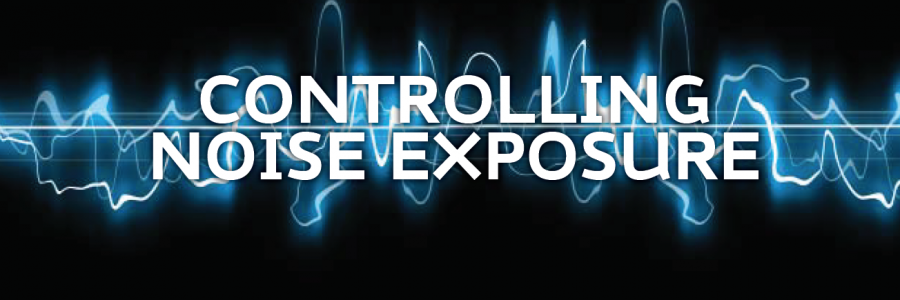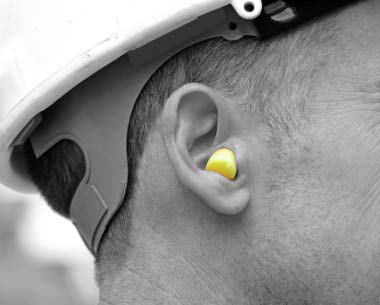
Controlling Noise Exposure
After determining worker exposure to noise, intervention may be needed to reduce noise exposures to allowable levels. There are three general ways to reduce to noise exposure, which are as follows (in order of preference):
• Engineering Controls
• Administrative Controls
• Personal Protective Equipment (PPE)
When engineering controls are not feasible to reduce exposures, administrative controls and PPE should be utilized, which are also discussed below. This paper describes common noise sources and possible noise control solutions.
ENGINEERING CONTROLS
Engineering controls are any modification or replacement of equipment, or related physical change at the noise source or along the transmission path that reduces the noise levels at the employee’s ear. Octave band analyzers help determine the type of frequency a piece of equipment produces, and clarify the type of modifications that are needed. Engineering controls should be the first order of protection and it does not include the use of hearing protection. There are different sources of workplace and community noise that could be targeted and modified such as:
• Vibrating surfaces (e.g., engines, electric motors, fans, etc.)
• Mechanical impacts (e.g., hammering, pile driving, grinding, etc.)
• Pulsating gas flow (e.g., pistons, jack hammers, pneumatic tools, etc.)
• Air flowing over a surface
• Compression and rarefaction of a medium (e.g., gears meshing, fan blades pushing and pulling air, etc.)
Refer to Table 1 for common noise sources and possible solutions.
When trying to modify the amount of noise through engineering controls, there are three areas that need to be targeted – the source, path, and receiver of the noise. The source of the noise can be modified or redesigned to produce less noise or at different frequencies. The source can be relocated to a protected location or distant location to attenuate noise. Noise can also be reduced by altering the path it takes. The transmission can be blocked using an enclosure or a barrier. Material can be placed around the perimeter of the equipment to absorb the noise. Receivers (e.g., workers) can also be sheltered within an enclosure to prevent the noise from reaching them. They may also be relocated, if feasible.
Other factors to consider when determining appropriate engineering controls are structure-borne noise, reflected noise, and direct noise transmission. By checking and improving vibration insulation, structure-borne noise may be reduced. Reverberation may be reduced by increasing the absorption on the area, thus eliminating reflected noise. The noise source may also be separated from its surroundings with a screen or a sound-insulating hood that is lined with sound absorbing material.
Table 1 – Common Noise Sources and Possible Solutions
| Source | Noise Emissions | Possible Solutions |
| Electric Motors | • Air turbulence around intake for cooling fan • Mechanical vibration of support structure | Air turbulence can be controlled by installing an air intake silencer or by changing out the motor fan blade to a more aerodynamic blade type. Mechanical vibration can be controlled by mounting the motor on isolation pads or mounts. |
| Compressed air | • Turbulence due to mixing of gases with different velocities • Turbulence caused by air impinging against fixed objects | Air turbulence can be controlled by reducing the velocity of air to as low as possible. Silencers should be installed on air exhaust points. Dust off nozzles can be replaced with “low-noise” types. Air ejection systems may sometimes be replaced with water systems. |
| Noise from pipelines, valves and ducts | • Transmission of vibration from fixed equipment • Turbulence caused by gas or fluid passing through the pipe/duct | Transmission of vibration can be controlled using vibration dampening treatments or isolators. Mounting piping/ducting on vibration isolating hangers is another option. Noise from turbulent flow can be controlled using pipe lagging. |
| Equipment housings | • Vibration transmitted by equipment | Housing vibration can be controlled by vibration dampening surface treatments. |
| Duct or stack noise | • Transmission of vibration from stack fans • Turbulence caused by gas flow | Duct or stack noise can be controlled by using noise cancellation using noise cancellation technology whereby a sound wave opposite to the offending noise is introduced resulting in a cancellation of the offensive noise. |
| Point sources from discrete pieces of equipment | • Mechanical vibration and resonance | Point sources can be controlled through “low noise” purchasing specifications, proper maintenance and if necessary, placing the equipment in an enclosure or behind a barrier. |
ADMINISTRATIVE CONTROLS
Administrative controls involve changes in the work schedule or operations that reduce worker noise exposure. Examples may include providing training to employees, posting signs in high noise areas, restricting employees from working in specific high noise areas, developing written procedures, and conducting periodic audiometric testing for employees. Administrative controls should not result in more workers being exposed to the noise. That is, rotating workers in and out of high noise areas is generally not a recommended exposure control strategy. The number of workers in the noise area should be limited. The time in the high noise area should also be minimized. Quiet lunch and break areas should be provided workers.
PERSONAL PROTECTIVE EQUIPMENT (PPE)
PPE for noise exposure consists of hearing protectors such as earplugs and earmuffs. Hearing protection devices are used to reduce the level of noise that reaches the middle and inner ear when engineering and work practice controls are not feasible and/or do not sufficiently reduced noise exposure below allowable limits. When selecting hearing protectors, the device should:
• Adequately reduce the noise to acceptable levels
• Fit your ears
• Be checked periodically for fit
• Be comfortable
• Be compatible with other PPE
• Be taken care of properly and replaced when deteriorated
There are a variety of styles of hearing protectors and each provide different levels of protection. Ear plugs are available as foam, pre-molded, and custom molded ear plugs. Hearing protectors are also available as canal caps and ear muffs.
The most common way to evaluate hearing protection is the noise reduction rating (NRR). Most manufacturers of hearing protection devices indicate the NRR for their product on the packaging, since it is required by the EPA. Appendix B of OSHA’s occupational noise standard (29 CFR 1910.95) requires that 7 dB be subtracted from the NRR when using A-weighted sound levels. Scientific literature indicates that laboratory-based ear attenuation data for hearing protectors are seldom achieved in the workplace. Therefore, applying an additional safety factor of 50% is recommended to adjust for workplace conditions.
NIOSH’s recommendations for de-rating the NRR is different than OSHA’s protocols. For earmuffs and formable earplugs, NIOSH recommends that 25% and 50% be subtracted, respectively, from the labeled NRR. For other earplugs, NIOSH recommends 70% of the manufacturer’s labeled NRR be subtracted.
 Wearing dual hearing protection (i.e., both earmuff and earplug in combination) does not equate to additive protection. Decibels cannot be added together like other numbers. Likewise, the NRRs of both the earmuff and earplug cannot be added together. There are no empirical or theoretically derived equations available that can predict the attenuation of an earplug and earmuff combination with sufficient accuracy to be useful. As a rule of thumb, the OSHA procedure of computing the dual protection to add five (5) dB to the NRR of the more protective of the two devices is a reasonable approximation.
Wearing dual hearing protection (i.e., both earmuff and earplug in combination) does not equate to additive protection. Decibels cannot be added together like other numbers. Likewise, the NRRs of both the earmuff and earplug cannot be added together. There are no empirical or theoretically derived equations available that can predict the attenuation of an earplug and earmuff combination with sufficient accuracy to be useful. As a rule of thumb, the OSHA procedure of computing the dual protection to add five (5) dB to the NRR of the more protective of the two devices is a reasonable approximation.
SUMMARY
Noise is frequently present above allowable exposure limits at construction and general industry worksites. Noise can have both auditory and non-auditory health effects. There is no cure for noise-induced hearing loss. Therefore, prevention of excessive noise exposure is the only way to preserve your hearing. Exposures to noise can be assessed by exposure monitoring. If exposure monitoring results indicated noise levels are above allowable levels, noise control strategies (such as feasible engineering controls, administrative controls, and PPE) should be employed.

Share This Article!

